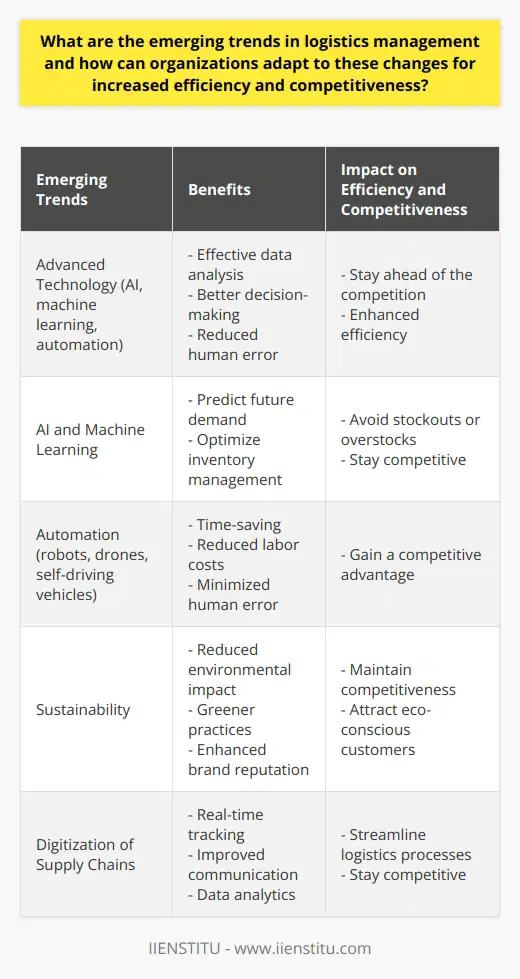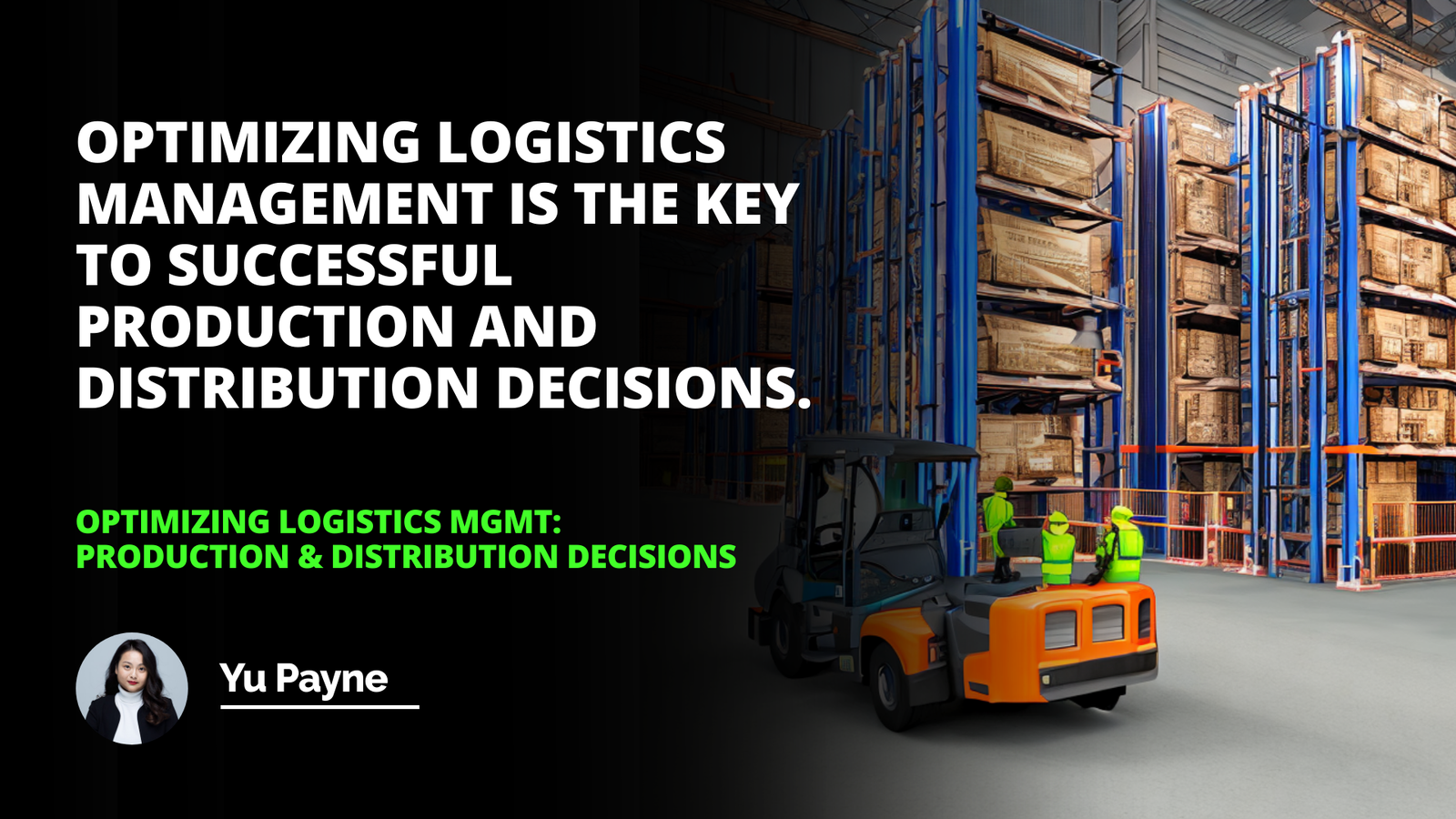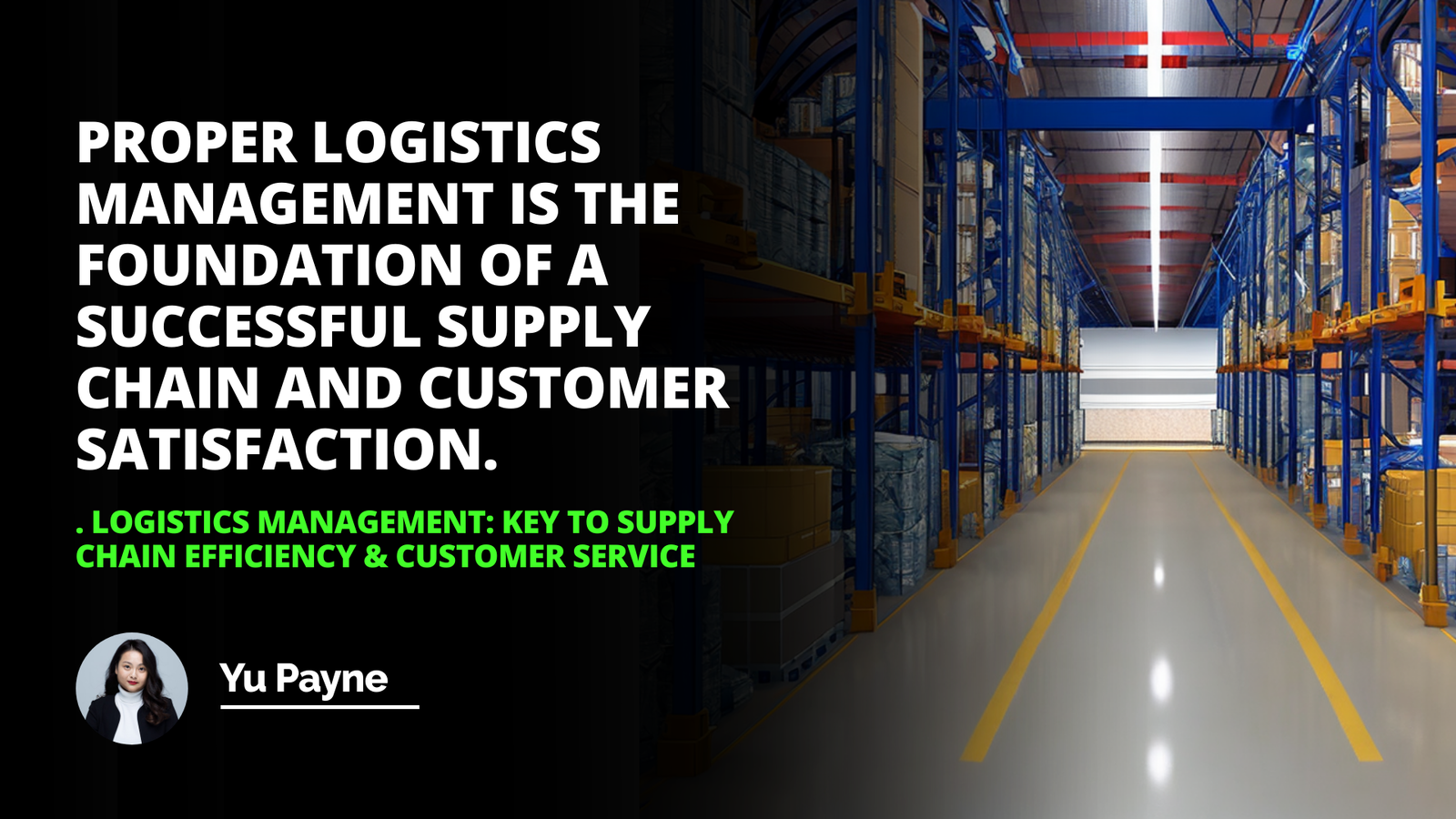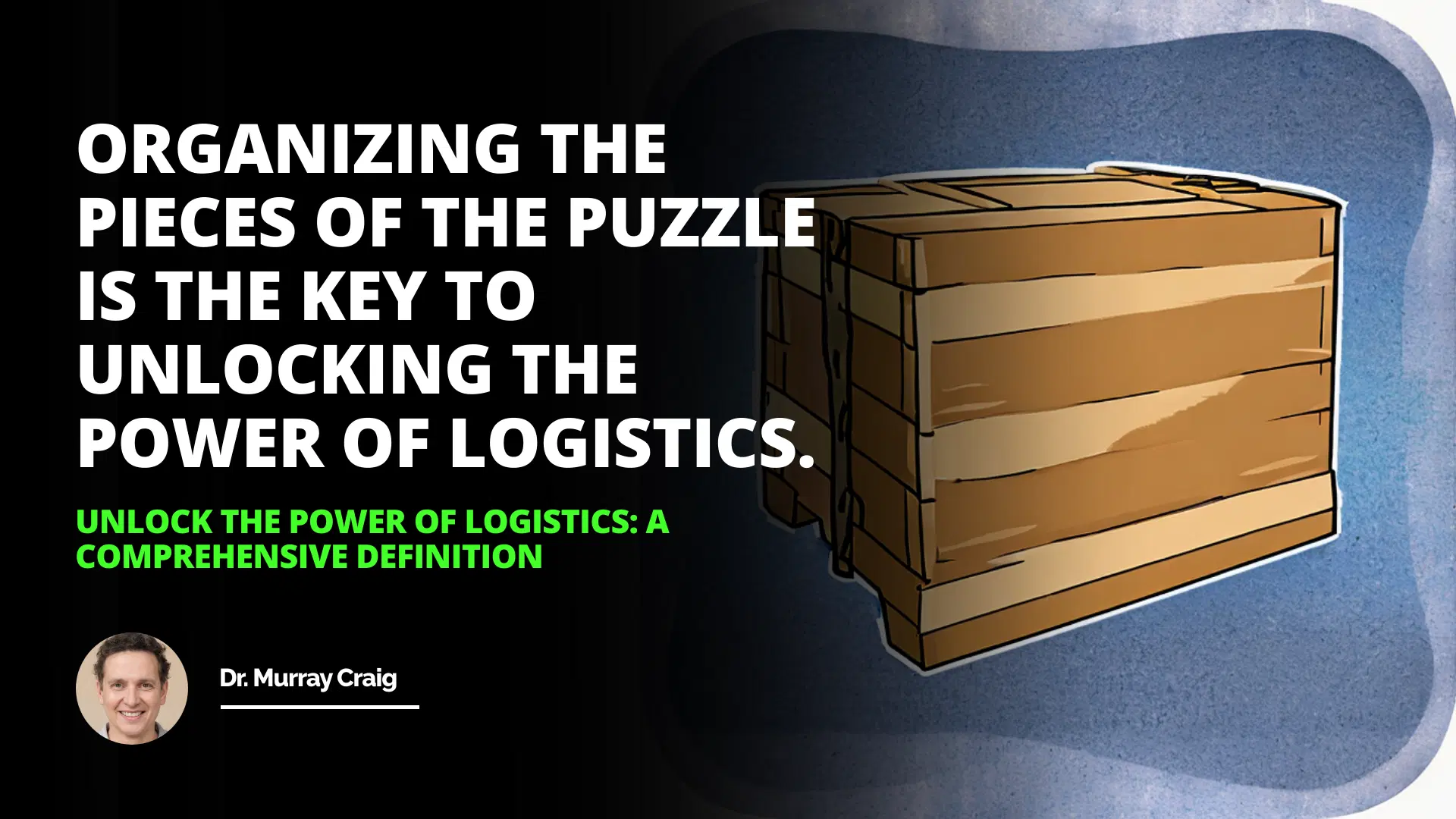
I still remember the day when I was anxiously waiting for a package to arrive—a birthday gift I'd ordered online for my father. The delivery was delayed, and the moment was spoiled. It was then I truly grasped the importance of logistics in our daily lives. We often take for granted the intricate processes that get products from a manufacturer’s floor to our doorstep. Logistics isn't just a buzzword tossed around in corporate meetings; it's the backbone that keeps businesses running and customers satisfied.
Definition of Logistics
Components of Logistics
Logistics’s Role in Business
Key Benefits of Logistics
Impact of Logistics on Companies
The Future of Logistics
Understanding the Essence of Logistics
Definition of Logistics
At its core, logistics is the art and science of managing the flow of goods, information, and resources from the point of origin to the point of consumption. It's about coordinating those moving parts so that everything arrives where it's supposed to, when it's supposed to. Think of logistics as the unseen hand that choreographs the complex dance of supply and demand.
I recall reading "Logistics & Supply Chain Management" by Martin Christopher, where he emphasizes that logistics is not just about transportation and warehousing; it's about creating value. By ensuring that products are available when and where customers want them, businesses can significantly enhance customer satisfaction and loyalty (Christopher, 2016).
Components of Logistics
Logistics is a multifaceted field encompassing several key components:
1- Inventory Management: Keeping track of stock levels to meet customer demand without overstocking.
2- Warehousing: Efficiently and safely storing goods until they're needed.
3- Packaging: Protecting products during transit and often influencing customer perception upon delivery.
4- Transportation: Moving goods from one location to another via road, rail, air, or sea.
Maximizing Inbound Logistics: Benefits, Challenges & Strategies
Analyzing the Role of Drones in Streamlining Supply Chain Processes
5- Distribution: Ensuring the final product reaches the customer in a timely manner.
Let me share an example from my cousin's small business. She runs an online handmade jewelry store. Early on, she struggled with inventory management, often running out of popular items. By implementing a simple tracking system and organizing her storage space effectively, she optimized her supply chain management process. These tips helped her meet customer demand more reliably, boosting both her sales and reputation.
The Indispensable Role of Logistics in Business
Logistics’s Role in Business
In today's fast-paced market, logistics plays a pivotal role in determining a company's success. It's not just about moving goods; it's about strategically planning and executing processes that add value at every stage.
For businesses, efficient logistics can:
Reduce operational costs by streamlining processes.
Improve customer satisfaction through timely deliveries.
Enhance competitiveness by adjusting quickly to market changes.
A few years back, I worked with a retailer who was struggling with delayed shipments and unhappy customers. By analyzing their logistics operations, we pinpointed bottlenecks in their transportation and warehousing processes. Implementing technology solutions like real-time tracking and automated inventory systems, they significantly improved their logistics efficiency. This transformation didn't happen overnight, but the results were remarkable.
Key Benefits of Effective Logistics
Effective logistics management offers numerous benefits, including:
Increased Productivity: Streamlined processes mean resources are used more effectively.
Cost Reduction: Eliminating inefficiencies lowers overhead expenses.
Greater Flexibility: Adaptability to fluctuating customer demands and market trends.
Competitive Advantage: Superior logistics can set a company apart from its competitors.
Improved Customer Loyalty: Reliable services build trust and encourage repeat business.
Organizing the pieces of the puzzle is the key to unlocking the power of logistics.

I remember attending a seminar where Dr. John Langley, a professor at Penn State University and author of "Supply Chain Management: A Logistics Perspective", discussed how companies like Amazon have leveraged logistics for competitive advantage (Langley et al., 2019). Their sophisticated logistics network allows for rapid delivery, which not only meets customer expectations but often exceeds them.
Impact of Logistics on Companies
The Ripple Effect
Logistics doesn't just impact the bottom line; it influences virtually every aspect of a company. Efficient logistics can lead to:
Enhanced Brand Image: Reliable delivery services build trust with customers.
Better Supplier Relationships: Efficient coordination strengthens partnerships.
Innovation Opportunities: Streamlined processes free up resources for innovation.
Consider the automotive industry. Manufacturers rely heavily on just-in-time (JIT) manufacturing processes, where components arrive precisely when needed on the assembly line. This system reduces inventory costs but requires flawless logistics coordination. Any hiccup can halt production, leading to significant losses.
Embracing Technology in Logistics
The Future of Logistics
Looking ahead, the future of logistics is undoubtedly intertwined with technological advancements. Innovations like artificial intelligence (AI), the Internet of Things (IoT), and blockchain technology are poised to revolutionize the industry.
Here are some ways technology is reshaping logistics:
1- Predictive Analytics: Using data to forecast demand and optimize inventory levels.
2- Automated Warehousing: Robots and automation streamline warehousing tasks.
3- Smart Transportation Systems: Enhancing route planning and fuel efficiency.
4- Blockchain: Increasing transparency and security in supply chains.
5- Drones and Autonomous Vehicles: Potentially transforming last-mile delivery.
I recently toured a warehouse utilizing AI-driven robots to pick and pack items. Watching these robots navigate the warehouse with precision was like stepping into the future. According to "The Digital Transformation of Logistics: Demystifying Impacts of the Fourth Industrial Revolution" by Prof. Jonas Craninckx, these technologies are not just sci-fi fantasies but practical solutions reshaping logistics (Craninckx, 2020).
Optimizing Your Supply Chain
For businesses looking to stay ahead, here are some practical tips to optimize your supply chain management process:
Leverage Technology: Implement inventory management software to track stock levels.
Build Strong Relationships: Collaborate closely with suppliers and logistics partners.
Invest in Training: Equip your team with the skills needed for efficient logistics management.
Monitor Performance: Use key performance indicators (KPIs) to assess and improve logistics operations.
Stay Agile: Be prepared to adapt processes in response to market changes.
These steps can significantly improve logistics efficiency strategies, ultimately benefiting both the company and its customers.
The Human Side of Logistics
Personal Reflections
Logistics isn't solely about systems and processes; it's also about people. The dedication of logistics professionals—from drivers to warehouse managers—is what keeps the wheels turning.
I once met a long-haul truck driver named Joe at a diner. Over a cup of coffee, he shared stories of navigating through storms to deliver essential goods. His commitment reminded me that behind every package delivered, there's a network of individuals working tirelessly.
How Logistics Impacts Customer Satisfaction
Efficient logistics directly influence customer satisfaction:
Timely Deliveries: Meeting delivery promises builds trust.
Product Availability: Well-managed inventory ensures products are in stock when customers want them.
Communication: Keeping customers informed about their orders enhances their experience.
In the age of instant gratification, customers expect fast and reliable service. Companies that excel in logistics are better positioned to meet these expectations.
Conclusion
In an increasingly interconnected world, the importance of logistics in modern business cannot be overstated. It's the backbone supporting the entire supply chain, ensuring that products and services reach consumers efficiently and effectively.
As companies strive to meet the ever-growing expectations of customers, particularly regarding speed and reliability, investing in robust logistics operations becomes crucial. Embracing technological advancements and adopting effective inventory management techniques are no longer optional but necessary steps for businesses aiming to thrive.
From my personal experiences and observations, it's clear that logistics will continue to evolve, shaping not only how businesses operate but also how we, as consumers, experience the world around us. Whether it's receiving a long-awaited gift on time or ensuring essential supplies reach those in need, logistics plays an integral role in our lives.
Let us remember that organizing the pieces of the puzzle is the key to unlocking the power of logistics.
References
Christopher, M. (2016). Logistics & Supply Chain Management (5th ed.). Pearson Education Limited.
Langley Jr., C. J., Coyle, J. J., Gibson, B. J., Novack, R. A., & Bardi, E. J. (2019). Supply Chain Management: A Logistics Perspective (11th ed.). Cengage Learning.
Craninckx, J. (2020). The Digital Transformation of Logistics: Demystifying Impacts of the Fourth Industrial Revolution. Routledge.
Frequently Asked Questions
What is the core definition of logistics?
Logistics is commonly used to describe the proficient coordination of the flow of goods and services between the point of origin and the end point of consumption. It is an essential part of today's supply chain industry. It is concerned with the efficient movement of resources in a given system. The core definition of logistics is centered around optimizing the use of resources to reach an organization's desired objective. It is driven by the goals of cost-effectiveness and reliability, usually regarding transporting goods and services from point A to point B.
Logistics as a concept is also closely related to supply chain management. It encompasses various activities, such as purchasing, storing, packing, transferring inventory, warehousing, and delivering goods and services. The core competency of logistics management lies in creating efficient and effective strategies for moving resources from one place to another. These strategies often involve complex logistical operations and require an in-depth knowledge of the inherent risks and variables associated with those operations.
The role of logistics in business and the broader economy has been studied extensively. Academic literature has mainly focused on analyzing the impact of logistics on cost and service performance. Logistics capabilities are indispensable in achieving price, service, and supply chain management objectives. Suppose a business is to remain competitive and successful in emerging markets. In that case, it will require a good grasp of the foundations of logistics theory and how to apply them in practice.
In conclusion, the core definition of logistics refers to the proficient and effective coordination of resources to maximize efficiency and minimize costs. It is an essential element of the supply chain industry. It requires detailed knowledge of the associated risks and variables. With the correct implementation of the right strategies, logistics can be leveraged as a much-needed tool in continually pursuing business efficiency and economic growth.
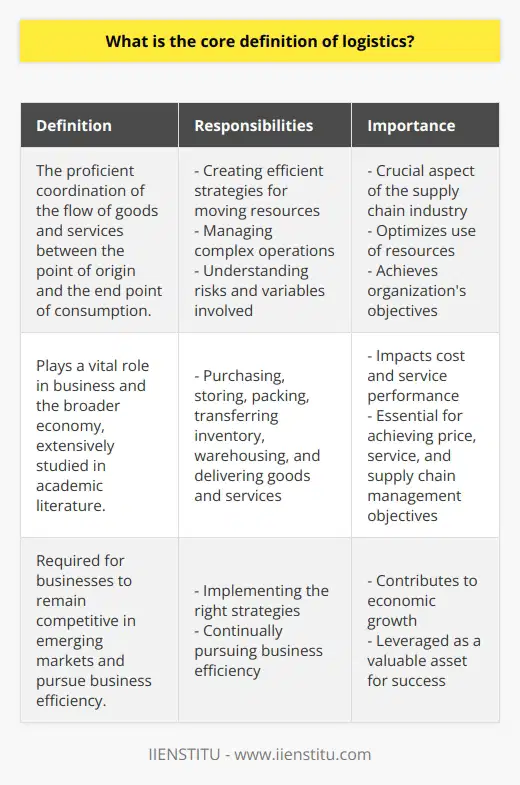
What impact does logistics have on businesses?
Logistics play an integral role in the success of any business. As such, it is essential to understand its impact on companies to ensure that operational processes are efficient and cost-effective.
Logistics is a highly complex operation involving numerous departments and locations. It encompasses the process of managing supplies, including the storage, transportation, and distribution of materials. Logistics is essential to keep businesses running, as it relates to delivering goods and services and supporting customer relations.
One way in which logistics can have an impact on businesses is in the form of its cost-saving potential. It is common for companies to need help with high costs related to transport and warehousing. Still, with the use of efficient logistics, these costs can be reduced considerably. In addition, logistics-related technology can help optimize operations, leading to further cost savings. Logistics can help reduce time delays and supply chain disruptions by improving the process of acquiring and delivering material.
Closely related to this is the impact of logistics on customer relations by ensuring that products are delivered on time. As expected, a business can satisfy customers and ensure a more decisive competitive advantage. This can also increase sales and revenue, as customers will be more likely to return to companies that provide reliable service. Further, improved customer relations can help reduce downtime, allowing businesses to stay competitive in their respective markets.
Finally, another critical factor affecting businesses is the speed and accuracy of information exchange within logistics. Utilizing the most up-to-date technology can promote transparency between the supply chain and internal departments, allowing quicker decision-making and implementation. In addition, businesses can better manage and forecast future trends by having accurate data, such as inventory levels and order tracking.
In conclusion, logistics significantly impact any business's success, and it is essential to understand how it can benefit operations. Logistics can help save costs, improve customer relations, and ensure the speed and accuracy of information exchange, which can help ensure competitiveness in the market. By recognizing and utilizing the advantages of efficient logistics, businesses can ensure their long-term success.

How can businesses unlock the power of logistics?
In today's hyper-competitive business environment, many companies have realized that effectively managing their supply chain and logistics operations is essential for success. Logistics is managing the flow of goods, information, and resources between the point of origin and the point of consumption to meet customer demands. Logistics is critical in many industries and can significantly influence profitability. As such, businesses must unlock the power of logistics to gain a competitive advantage.
The foundation of a successful logistics strategy begins with understanding customer needs. Customers have specific requirements for their orders and will ultimately judge how well the logistics chain is working. Therefore, businesses must keep up with customer demand trends and proactively adjust their supply chain operations to meet customer demands.
It is also essential for businesses to determine the most effective modes of transportation for their goods. For example, understanding the cost benefits of different transportation modes and aligning them with customer orders can help companies minimize operating costs while meeting customer expectations.
Additionally, businesses must seek to reduce the complexities of their supply chain and logistics operations. This can be accomplished through the use of technology and advanced analytics. Technology can help improve the visibility of the entire supply chain, reduce errors, and provide real-time insights into customer needs. Advanced analytics can identify hidden cost savings opportunities and address operational inefficiencies.
Finally, businesses must ensure their supply chain and logistics operations are secure. This means that companies must implement measures to protect their data, prevent unauthorized access, and ensure the safety of their products during transit.
By understanding customer needs, optimizing transportation options, reducing complexities, and ensuring supply chain security, businesses can unlock the power of logistics and gain an edge over the competition. Leveraging logistics is essential to any comprehensive business strategy and should be noticed.
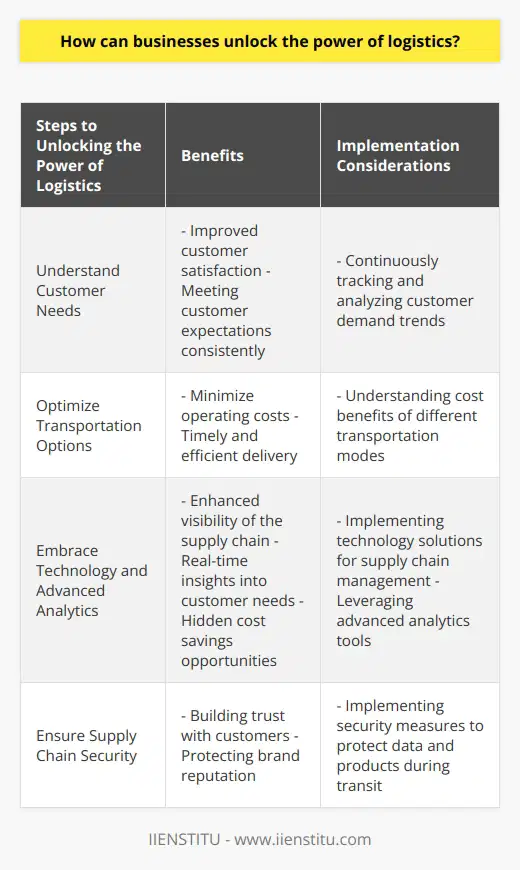
What is a simple definition of logistics?
Defining Logistics
Logistics, in its most rudimentary form, refers to the process of managing the efficient flow of goods, information, and resources from the point of origin to the point of consumption. This management process encompasses various aspects, including transportation, storage, and handling of products and materials, in order to fulfill customer demands in a timely and cost-effective manner.
Key Elements of Logistics
There are several crucial elements involved in logistics to ensure the smooth functioning of the entire system. These key elements can be broadly categorized into the following:
Transportation: This involves the movement of goods and materials from one location to another using different modes of transportation such as air, sea, rail, or road.
Warehousing and Storage: It refers to the storing of goods in a designated facility, either temporarily or for a longer duration until it is required for further use or distribution.
Material Handling: This refers to the process of loading, unloading, and moving goods within a warehouse or storage facility.
Inventory Management: This involves tracking and maintaining an optimum level of goods and raw materials in the supply chain to fulfill the end-customer demands effectively.
Order Fulfillment: This is the process of processing, packing, and dispatching a customer's order, ensuring that it reaches the desired destination within the stipulated time frame.
Information Management: The critical aspect of managing essential data related to the movement of goods and ensuring the timely and accurate sharing of information among different parties involved in the supply chain process.
Role of Logistics in Supply Chain Management
Logistics plays a significant role in the broader concept of supply chain management (SCM). SCM encompasses a wide range of activities, including sourcing, procurement, production, and logistics, working together to deliver the final product to the end customer. Effective logistics management is essential for the seamless functioning of the supply chain, ensuring that there is a constant and efficient flow of goods and information throughout the supply chain process.
In conclusion, logistics is a fundamental aspect of any business or industry, ensuring that goods and services are delivered to the end customer in a timely and cost-effective manner. By effectively managing logistics operations, businesses can enhance their overall efficiency, reduce operational costs, and maintain a competitive edge in today's dynamic market landscape.
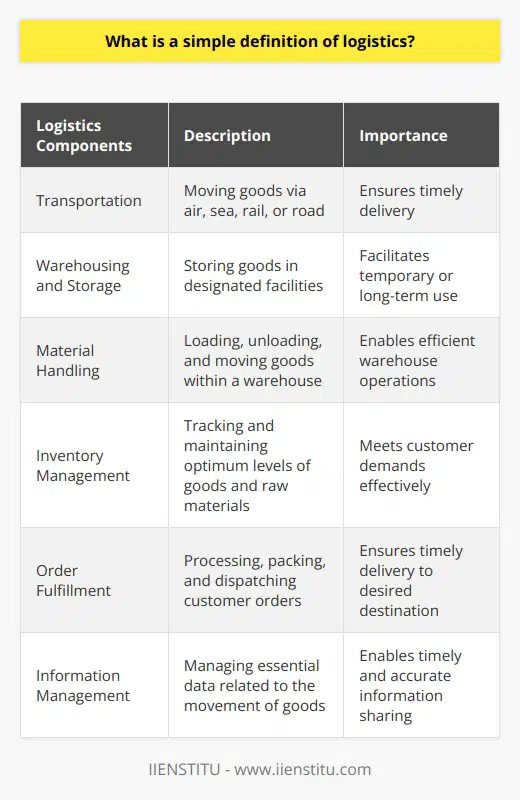
What are the 5 definitions of logistics?
**Definition One: Military Logistics**
Logistics has its roots in military operations, where it refers to the planning, organization, and execution of activities involved in the movement and maintenance of military forces. This includes the procurement, distribution, and storage of supplies, as well as the transportation of personnel and equipment.
**Definition Two: Business Logistics**
In the business context, logistics encompasses the coordination of various activities required to move a product from its point of origin to its point of consumption. These activities include transportation, inventory management, warehousing, and order fulfillment, all aimed at ensuring that products are delivered to customers efficiently and effectively.
**Definition Three: Logistics in Supply Chain Management**
Within the broader concept of supply chain management (SCM), logistics is the management of the flow of goods, information, and resources between the points of origin and consumption. This involves the integration of activities such as procurement, production, transportation, and distribution, with the ultimate goal of satisfying customer requirements.
**Definition Four: Reverse Logistics**
Reverse logistics is the lesser-known counterpart to the traditional, forward-moving logistics activities described above. It involves the collection, transportation, and processing of discarded, returned, or damaged goods, as well as the management of all related activities (e.g., disposal, recycling, and refurbishment).
**Definition Five: Green Logistics**
Green logistics takes a more environmentally conscious approach to the planning and execution of all logistics activities. It seeks to minimize the ecological impact of transporting, storing, and handling goods by promoting the use of energy-efficient technologies, reducing waste, and implementing sustainable practices throughout the supply chain.
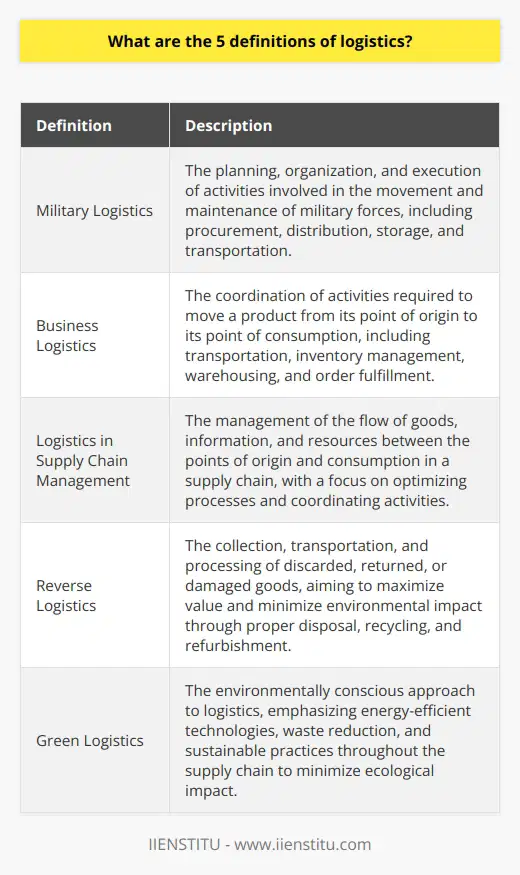
What is comprehensive in logistics?
Understanding Comprehensive Logistics
Comprehensive logistics encompasses all aspects of the supply chain management process, ensuring efficient movement of goods from the point of origin to the final destination. It aims to optimize delivery times, transportation costs, and storage requirements by integrating various logistics functions, such as transportation, warehousing, and inventory management. This holistic approach provides businesses with improved visibility, control, and decision-making abilities, ultimately contributing to their overall success and better customer satisfaction.
Key Components of Comprehensive Logistics
Transportation management:
An essential aspect of logistics is the selection, execution, and management of transportation modes to move goods and materials between locations. Choosing the most suitable transportation method can reduce costs and enhance overall efficiency.
Warehousing and storage:
Effective warehousing and storage strategies allow businesses to maintain optimal inventory levels and protect goods from damage or degradation until they are required for consumption or shipment.
Inventory control:
Accurate and real-time inventory control systems help businesses track and manage their goods, prevent stockouts or overstocks, and enable informed decisions regarding production planning and forecasting.
Order management:
This involves efficiently processing and fulfilling customer orders while maintaining essential records to avoid discrepancies and confusion.
Customer service:
Providing timely, accurate, and helpful information to customers regarding their orders is crucial for maintaining long-term relationships and ensuring customer satisfaction.
Data analysis and decision support:
Utilizing advanced analytics tools and techniques can improve decision-making, identify inefficiencies, and predict future trends, leading to better overall performance.
Risk management:
Identifying and mitigating supply chain risks, including disruptions, delays, and other external factors, is a vital aspect of comprehensive logistics management.
By implementing comprehensive logistics practices, businesses can achieve cost savings, operational efficiencies, and enhanced customer experiences. Additionally, this strategic approach can support the long-term growth and sustainability of organizations by adapting to market changes and evolving customer demands.
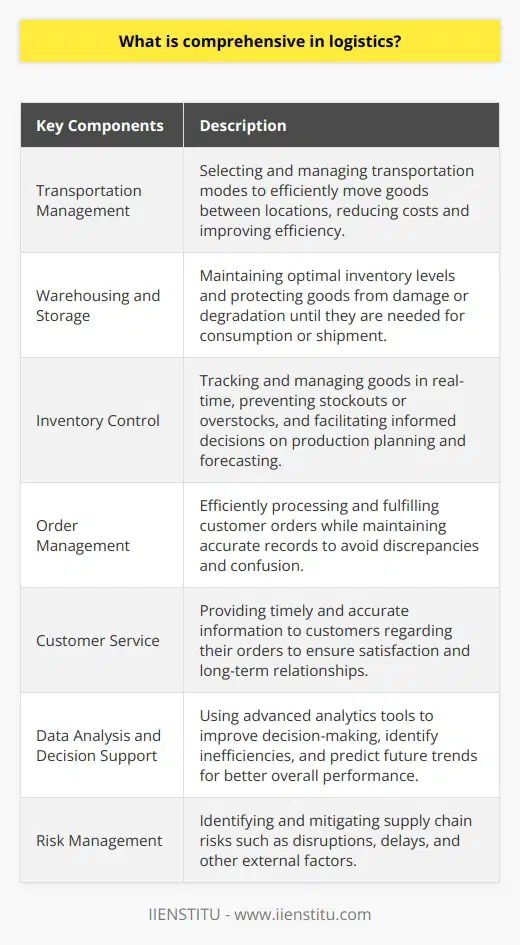
What is the role of technology in improving logistics processes?
Role of Technology in Logistics Enhancement
**Streamlining Operations**
The key role of technology in improving logistics processes is to streamline operations, reducing manual labor, and minimizing errors. Technological advancements, such as automation and algorithms, enable companies to optimize their warehouse management, inventory control, and transportation strategies.
**Reducing Costs and Increasing Efficiency**
Furthermore, technology helps reduce costs and increase efficiency in logistics through the implementation of software systems that provide real-time data and insights. Such systems allow businesses to make informed decisions regarding supply chain management, enabling them to respond quickly to fluctuations in demand and avoid potential bottlenecks.
**Enhancing Communication and Collaboration**
Another essential role of technology in the logistics industry is improving communication and collaboration between different stakeholders, including suppliers, carriers, and customers. This is achieved through the use of advanced communication tools, such as GPS tracking devices, electronic data interchange (EDI), and cloud-based platforms, which facilitate information sharing and support better decision-making.
**Ensuring Security and Compliance**
Moreover, technology plays a crucial role in ensuring security and compliance within logistics processes by implementing advanced tracking systems and secure data transmission protocols. This allows companies to monitor their cargo's location and condition in real-time while safeguarding sensitive information from potential threats, helping them meet increasingly stringent regulations and industry standards.
**Fostering Sustainability and Environmental Consciousness**
Lastly, technology allows logistics companies to incorporate more sustainable practices into their operations, reducing their environmental impact. Innovations like electric vehicles, renewable energy sources, and smart technologies contribute to lowering emissions, minimizing waste, and promoting the efficient use of resources.
In conclusion, technology is integral to the evolution of the logistics landscape, streamlining operations, enhancing efficiency, improving communication, ensuring security and compliance, and fostering environmentally-conscious practices. By embracing these technological advancements, logistics providers can stay competitive and relevant in an ever-changing global market.

How do environmental factors influence logistics management?
Environmental Factors Impact on Logistics
Environmental factors significantly influence logistics management in numerous ways. Such factors are primarily external and can be classified under political, economic, social, technological, legal, and environmental categories. Understanding these factors is essential in optimizing logistics management and its operations.
Political and Legal Factors
Government policies and international trade regulations play a significant role in logistics management. For instance, import and export regulations, customs duties, and tariffs impact the cost and time efficiency of transportation. Additionally, governments may impose environmental rules or safety regulations that logistics companies must adhere to, thus affecting their operations.
Economic Factors
The overall economic climate affects the movement of goods and logistics management. During recessionary periods, reduced demand for goods may lead to downsizing or even closure of certain logistics operations. Conversely, a thriving economy may foster expansion and lead to additional opportunities. Currency exchange rates and fuel prices also play an essential role in shaping logistics costs.
Social and Cultural Factors
Consumer tastes and preferences can have a direct influence on logistics management. For example, an increasing demand for eco-friendly and sustainable products may lead logistics companies to adopt green initiatives such as reducing carbon emissions or using recycling practices. Additionally, labor union activities and wage regulations can affect the cost and availability of the workforce in logistics management.
Technological Factors
Technological advancements have revolutionized the logistics industry, making operations more efficient and cost-effective. Innovations such as GPS tracking, automated warehouses, drone deliveries, and e-commerce platforms have transformed logistics management. Companies that fail to adopt these technologies may struggle to remain competitive and achieve optimal performance.
Environmental Factors
Logistics operations can have a noticeable impact on environmental sustainability. Both natural and man-made environmental factors such as climate change, natural disasters, and air pollution influence logistics management. Incorporating environmentally friendly practices (e.g., using alternative energy sources, waste reduction, or efficient packaging materials) is becoming increasingly important for logistics companies to minimize negative effects on the environment.
In conclusion, environmental factors have a multifaceted impact on logistics management. To maximize efficiency and competitiveness, logistics companies should continuously monitor and adapt to these ever-changing factors by investing in technology, embracing sustainability initiatives, and complying with relevant regulations.
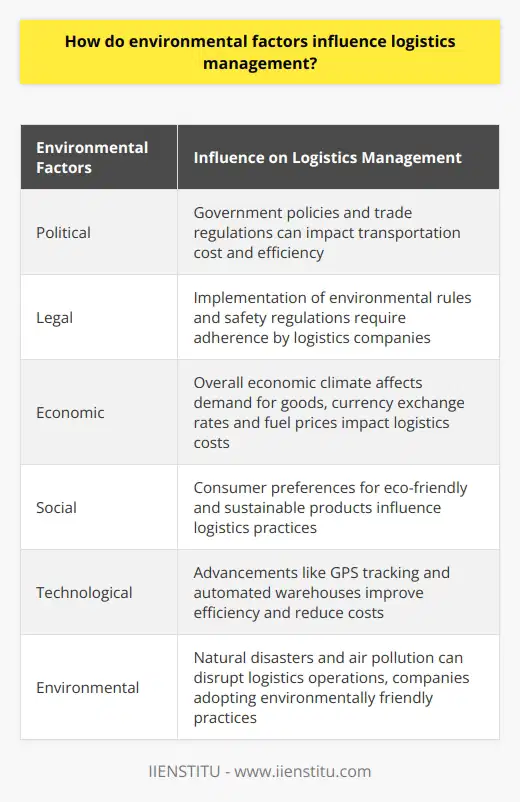
What are the key challenges faced by organizations in implementing efficient logistics strategies?
Challenges in Implementing Logistics Strategies
Organizations face several key challenges in implementing efficient logistics strategies. This academic discussion focuses on three main difficulties: lack of information, insufficient infrastructure, and organizational culture.
Insufficient Information and Visibility
One major challenge lies in inadequate information and visibility into the supply chain. Obtaining accurate and timely information on inventory levels, shipment status, and demand forecasts is crucial for designing effective logistics strategies. A lack of reliable data can lead to poor decision-making and reduced efficiency.
Inadequate Infrastructure
Another significant challenge is the inadequacy of available infrastructure. For efficient logistics, organizations need robust transportation networks, including roads, ports, and airports. Additionally, sufficient storage facilities and modern technology systems are required for seamless operations. In many cases, businesses have to work with underdeveloped or poorly maintained infrastructure, which results in delays, increased costs, and compromised service quality.
Organizational Culture
Lastly, the organizational culture can pose challenges to adopting effective logistics strategies. Employees may resist new processes or technology out of fear of change or uncertainty. Furthermore, communication issues and the lack of collaboration between departments can hinder the execution of well-designed logistics plans. Encouraging a culture of continuous improvement, flexibility, and open communication can help organizations overcome these challenges.
In conclusion, organizations seeking to implement efficient logistics strategies must address issues such as insufficient information, inadequate infrastructure, and resistant organizational culture. By addressing these challenges proactively, businesses can optimize their logistics processes, enhance customer satisfaction, and ultimately, achieve competitive advantages in the market.
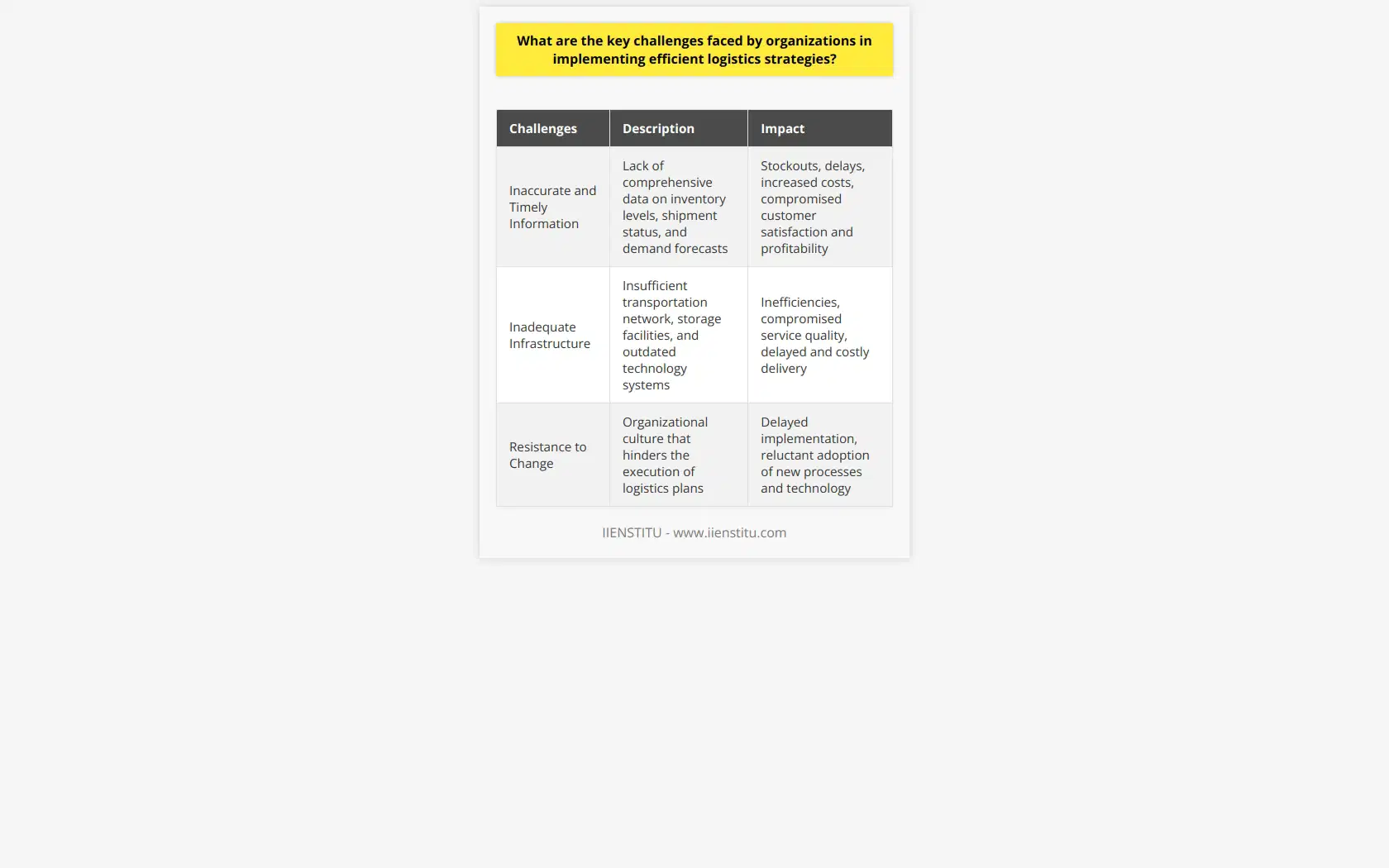
What are the key components of an effective logistics system?
Key Components in Effective Logistics Systems
Efficient Transportation
A critical aspect of successful logistics systems is efficient transportation, which facilitates the smooth movement of goods from one location to another. Utilizing a combination of different modes, such as road, rail, air, and sea transport, ensures timely deliveries and reduced lead times, thus improving overall customer satisfaction.
Inventory Management
Effective logistics systems also rely on proper inventory management, which includes keeping track of available stock, forecasting future demands, and calculating appropriate safety stock levels. Through the use of modern software, companies can streamline their inventory management processes and minimize the risk of stockouts or overstocking, thereby reducing unnecessary storage costs.
Warehouse Management
A well-organized warehouse is another key component of a robust logistics system. Implementing an effective warehouse management strategy entails the deployment of advanced technology and software, which allows for accurate tracking, storage, and retrieval of stock items. Furthermore, warehouse layout and design play a critical role in ensuring efficient material flow and minimizing handling costs.
Information Technology and Integration
The integration of information technology (IT) systems is crucial in facilitating communication, coordination, and visibility throughout the entire supply chain. By employing cutting-edge software and tools, businesses can optimize their logistics processes, ensure data accuracy, and maintain real-time visibility of inventory and shipments. Additionally, IT integration contributes to enhanced collaboration between suppliers, manufacturers, and distribution partners.
Network Design
An optimally designed logistics network enables organizations to maintain a balance between cost efficiency and service quality. Factors such as the location of distribution centers, transportation routes, and supplier selection play a significant role in determining the overall success of the logistics system. Regularly analyzing and updating the network design supports adapting to changing market conditions and customer demands.
Performance Measurement
Lastly, an effective logistics system incorporates performance measurement systems to monitor, evaluate, and improve its overall efficiency. Key performance indicators (KPIs), such as on-time delivery rates, order accuracy, and inventory turnover, enable businesses to assess their logistics performance and identify areas for improvement. By implementing continuous improvement initiatives, companies can enhance their logistics systems, achieve higher customer satisfaction levels, and increase their competitive advantage.
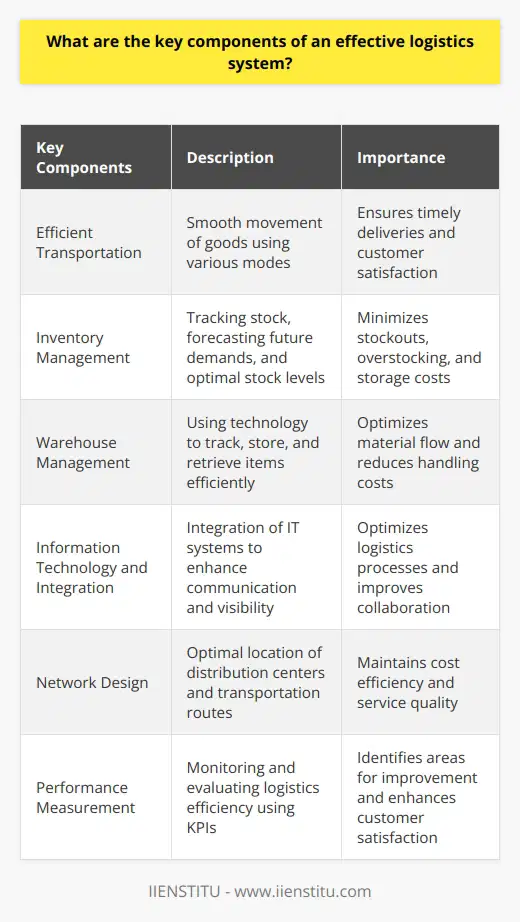
In what ways do logistics management strategies contribute to a company's competitive advantage?
**Logistics Management Strategies and Competitive Advantage**
Effective logistics management strategies contribute to a company's competitive advantage through various ways, including cost reduction, improved customer service, and increased efficiency.
**Cost Reduction**
One major way logistics management strategies contribute to a company's competitive advantage is by reducing operational and transportation costs. By optimizing shipping routes, scheduling regular maintenance for vehicles, and implementing advanced technology, companies can lower expenses and allocate more resources to improving products or services. This cost reduction enables businesses to offer competitive prices while maintaining or increasing profitability.
**Improved Customer Service**
An efficient logistics system ensures that customers receive their orders on time and in the desired condition. By streamlining the order fulfillment process, companies can provide a seamless and positive customer experience, leading to increased customer satisfaction and loyalty. Moreover, advanced tracking systems enable customers to monitor their shipments, further enhancing transparency and trust between businesses and their clients.
**Increased Efficiency**
Implementing logistics management strategies like Just-in-Time (JIT) inventory systems and warehouse automation helps companies optimize their supply chain operations. These strategies allow businesses to manage inventory levels more effectively, avoiding stockouts or overstocking, and ensuring that goods are always available for timely delivery. An efficient supply chain ultimately leads to better overall performance, enabling companies to respond to market fluctuations and customer demands more quickly.
**Environmental Sustainability**
Environmentally responsible logistics management practices, such as using energy-efficient vehicles or consolidating shipments, can contribute to a company's competitive advantage by improving its sustainability efforts. These practices not only reduce the company's carbon footprint but also appeal to environmentally conscious customers and stakeholders, helping businesses stand out in today's eco-focused market.
In conclusion, logistics management strategies play a significant role in a company's competitive advantage by reducing costs, improving customer service, increasing efficiency, and promoting environmental sustainability. By optimizing their logistics operations, businesses can not only boost their financial performance but also enhance their reputation and customer relationships.

How do different types of transportation affect logistics efficiency and effectiveness?
Impact on Efficiency and Effectiveness
Various types of transportation play a crucial role in determining the efficiency and effectiveness of logistics operations. Factors such as speed, cost, and environmental impact directly influence the choice of transportation mode, which subsequently affects the overall performance of the logistics chain.
Ground Transportation
Ground transportation, comprising of road and rail, is a widely used and accessible mode for transporting goods. The extensive road network offers flexibility in routing and scheduling, making it suitable for short and medium distances. However, road transport may face delays due to traffic congestion, impacting the efficiency and timeliness of deliveries. Rail transport, on the other hand, can handle larger volumes of cargo and is considered more energy-efficient than road transport. Nevertheless, it may require additional handling and transfers, introducing potential inefficiencies and delays.
Maritime Transportation
For long-distance and intercontinental shipments, maritime transportation is the preferred mode due to its comparatively low cost and high cargo capacity. Despite the longer transit time associated with sea transport, it remains an effective solution for bulk shipments or large quantities of goods. However, port congestion and varying shipping schedules can pose challenges to the efficiency of maritime transportation.
Air Transportation
Air transportation offers the advantage of speed, enabling rapid delivery of goods over long distances. This mode is particularly effective for time-sensitive or high-value products that require expedited delivery. While air transport is typically more expensive than other options, its efficiency and effectiveness in specific situations can outweigh the cost factor.
Intermodal Transportation
Combining multiple modes of transport, intermodal transportation presents a flexible solution that allows businesses to select the optimal combination of speed, cost, and environmental impact according to their logistics requirements. By integrating various modes and leveraging their comparative advantages, intermodal transportation can enhance the overall efficiency and effectiveness of the logistics process.
In conclusion, the choice of transportation mode significantly impacts the efficiency and effectiveness of logistics. Ground, maritime, air, and intermodal transportation present distinct advantages and disadvantages, making it essential for businesses to carefully evaluate their options and determine the most appropriate solution for their specific logistics needs.
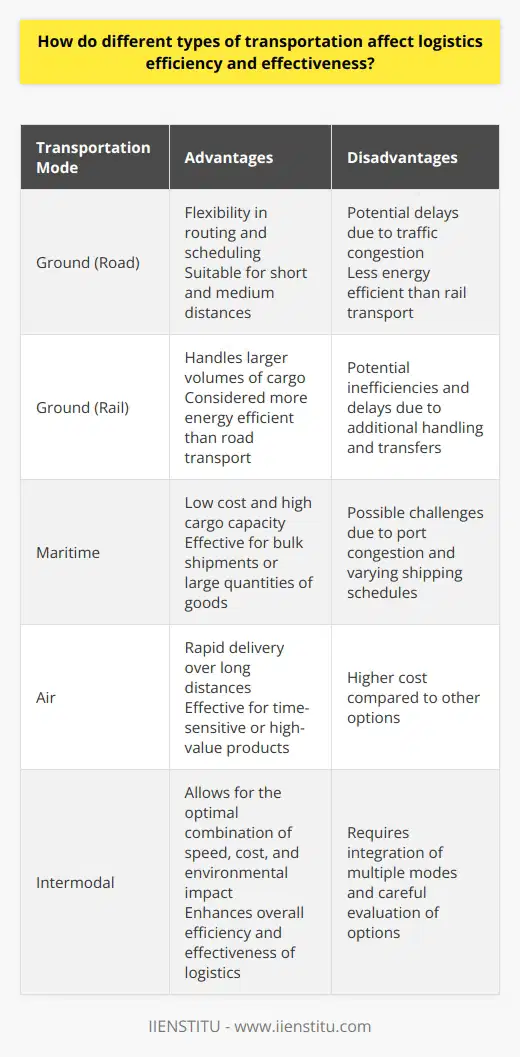
What is the best explanation of the use of logistics?
Significance of Logistics in Modern Operations
In today's highly competitive and globalized business environment, the best explanation for the use of logistics is its critical role in enhancing operational efficiency, ensuring seamless product distribution, and optimizing costs. Utilizing logistics effectively allows businesses to meet consumer demands and address the challenges associated with supply chain management.
Role of Logistics in Supply Chain Management
Effective logistics management contributes to the smooth functioning of supply chain management by enabling companies to transport raw materials and finished products between supplier facilities, manufacturing units, and distribution centers. These strategic procedures are vital to maintain the flow of goods and services, to prevent potential disruptions, and to deliver products to customers in a timely manner.
Influence on Competitive Advantage
Logistics plays a crucial role in gaining a competitive advantage in the market, as it directly affects the company's ability to deliver products on time, at the right place, and in the desired condition. When logistics is handled efficiently, it can lead to increased customer satisfaction, improved brand reputation, and a higher likelihood of customer retention.
Cost Optimization and Sustainability
One of the primary functions of logistics is the optimization of costs related to the movement, storage, and processing of goods. This involves streamlining transportation, inventory management, and order fulfillment procedures to minimize operational expenses. Additionally, adopting sustainable logistics practices can significantly reduce the environmental impact of business operations, contributing to corporate social responsibility.
Technological Advancements in Logistics
The integration of modern technologies, such as artificial intelligence, machine learning, blockchain, and the Internet of Things (IoT), has revolutionized logistics management. These technological advancements are being leveraged to create more efficient and effective logistics processes, such as real-time tracking of shipments, automated warehousing, and order delivery using drones.
In conclusion, the use of logistics in today's complex and well-connected business ecosystem is best attributed to its significance in improving operational efficiency, delivering products to customers, and optimizing overall costs. Additionally, logistics enables businesses to remain competitive and adopt sustainable practices while embracing technological advancements to enhance their processes.

What are the 4 rights in logistics?
Rights in Logistics: Overview
Logistics processes involve managing the flow of goods and information from the point of origin to the point of consumption. Achieving efficiency and effectiveness in logistics often involves ensuring that certain rights are met – the Four Rights of Logistics. These rights ensure the optimal performance of logistics processes and satisfy the needs of the end consumer.
Right Product
The first right emphasizes that correct goods are procured, stored, and delivered to meet customer requirements. Accuracy in product identification and management is critical to avoid any potential discrepancies that could result in customer dissatisfaction, unnecessary cost, or delayed delivery times. Proper documentation, inventory management, and tracking systems are essential to ensure the right product is always available and delivered to the customers.
Right Place
The second right entails the strategic positioning and timely delivery of goods to their destination. Selecting suitable transportation modes, routes, and distribution centers is essential to achieve cost efficiency and minimize delivery time. Good location planning and routing can also mitigate risks due to unforeseen events, such as traffic congestion, weather conditions, or restricted access to certain areas.
Right Time
The right time refers to the delivery of the product within the promised time frame, ensuring customer satisfaction and minimizing storage costs. Accurate demand forecasting and efficient planning of transport schedules play an essential role in guaranteeing timely delivery. Additionally, real-time monitoring and communication systems enable logistics managers to track the progress of shipments and respond proactively to any unexpected delays.
Right Condition
Lastly, ensuring that the goods reach the customers in perfect condition is crucial. Adequate storage conditions, appropriate packaging, and careful handling throughout the logistics process are necessary to maintain product quality and integrity. A thorough understanding of regulatory requirements, product-specific storage and handling conditions, and proper employee training contribute to achieving the right condition in logistics processes.
Conclusion
In conclusion, meeting the Four Rights of Logistics is crucial for organizations to enhance their logistics processes, stay competitive in the market, and ensure customer satisfaction. By focusing on delivering the right products, to the right places, at the right time, and in the right condition, companies can optimize their logistics performance and contribute to their overall success.
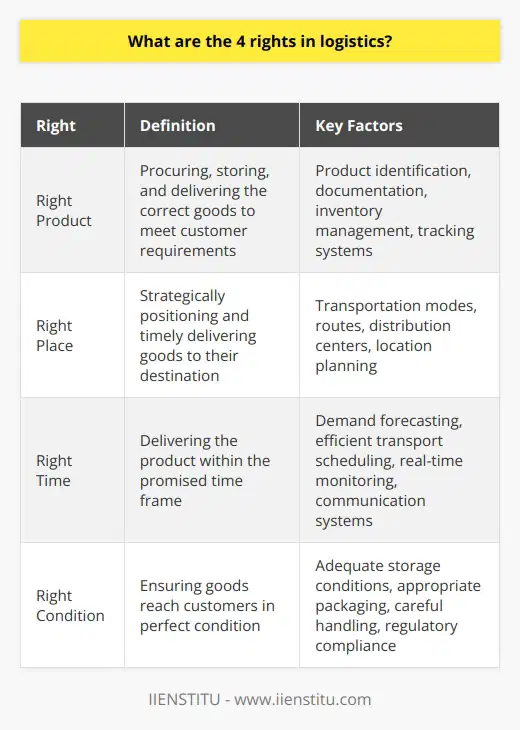
How do different types of transportation affect logistics efficiency and effectiveness?
Impact on Efficiency
The efficiency of a logistics system is significantly influenced by the varying types of transportation. For instance, air freight offers rapid delivery and a wider geographical coverage, accelerating overall logistics processes. In contrast, rail transportation provides cost-effective solutions, particularly for bulk cargo over long distances, even though it typically takes longer than air freight.
Effectiveness of Transportation Modes
Effectiveness in logistics is focused on meeting customers' demands by providing the appropriate transportation mode. Road transportation is versatile and provides door-to-door services, enhancing the satisfaction levels of customers. In comparison, maritime transportation offers the ability to move large volumes of goods at relatively lower costs, making it an effective option for expansive international trade.
Integration of Multiple Modes
The functionality of logistics improves as businesses adopt multimodal transportation strategies. By combining various modes, operators can optimize delivery times, reduce costs, and minimize environmental impacts. For instance, applying intermodal freight transportation, which consolidates different modes like road and rail, can streamline the supply chain process, subsequently enhancing overall efficacy.
Environmental Implications
Different types of transportation affect logistics efficiency and effectiveness through their relative impact on the environment. For example, road and air freight emit higher carbon emissions compared to rail and maritime transportation. As companies increasingly prioritize emission reductions, consideration of environmental consequences becomes essential in determining the most suitable transportation method.
Technological Advancements
Technological innovations across transportation modes substantially influence logistics efficiency and effectiveness. For instance, autonomous vehicles and drones offer potential to revolutionize road and air freight, improving speed and reducing labor costs. Similarly, developments in fuel efficiency and emission reduction technology in the maritime and rail sectors contribute to an environmentally sustainable logistics industry.
In conclusion, various types of transportation modes significantly impact logistics efficiency and effectiveness. The choice of transportation is often dictated by factors such as delivery times, costs, customer demands, sustainability, and technological advancements. Integrating multiple modes and embracing technological innovations stands to further enhance the overall functionality of logistics systems.

What is the most important thing in logistics?
Efficiency: The Essence of Logistics
In the field of logistics, efficiency stands out as the most important factor, encompassing various aspects such as time, cost, resources, and communication. Effective logistics management is critical for organizations to ensure timely delivery of goods, optimize resources, minimize costs, and maintain a competitive edge in the market. Achieving high efficiency in logistics processes entails accurate planning, execution, and monitoring of resources and activities across the entire supply chain.
Role of Time Management
Time management is a crucial component of efficient logistics operations. Streamlining processes to reduce lead times, minimize delays, and eliminate bottlenecks can significantly improve overall delivery times. Appropriate scheduling, routing, and real-time tracking of shipments contribute to better time management in the supply chain, ultimately enhancing customer satisfaction.
Utilization of Resources
Efficient logistics management involves the optimal use of resources, including manpower, equipment, and technology. Leveraging advanced technological solutions, such as automation, data analytics, and artificial intelligence, can help companies optimize resource allocation, improve decision-making, and minimize wastage. Furthermore, investing in workforce training and development can enhance skills and productivity, fostering a more resource-efficient environment.
Cost Optimization
Through efficiency-driven logistics operations, companies can maintain cost-effectiveness in the supply chain. Practices such as consolidating shipments, negotiating carrier rates, and reducing inventory levels contribute to cost optimization. Effective monitoring and control of logistics expenses, in conjunction with continuous improvement initiatives, allow organizations to identify cost reduction opportunities and maintain a healthy financial performance.
Fostering Effective Communication
Efficient logistics rely on streamlined communication between different parties, such as suppliers, carriers, and customers. Effective communication not only ensures better coordination but also allows for proactive identification and resolution of potential issues. Utilizing modern communication channels, such as cloud-based platforms and mobile applications, can facilitate information sharing and collaboration among stakeholders, thereby enhancing logistics efficiency.
To conclude, efficiency is the most important aspect of logistics management, encompassing several key elements like time, cost, resources, and communication. By striving for efficiency across all dimensions, organizations can improve their logistics operations and maintain a competitive advantage in the market.
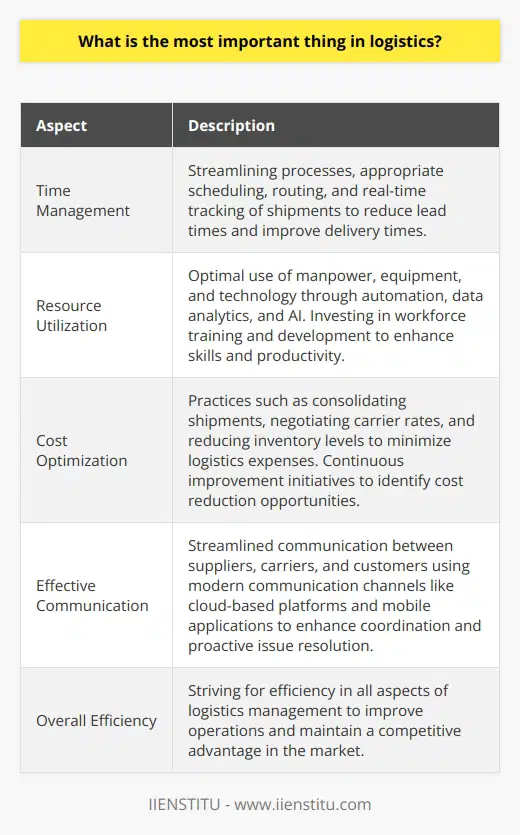
How do globalization and international trade affect logistics management?
Impact on Supply Chain Networks
Globalization and international trade have immense effects on logistics management, primarily by increasing the complexity of supply chain networks. The expansion of global trade opportunities leads to an extended geographical reach to source raw materials and finished goods. Consequently, logistics managers now coordinate materials from various countries, accommodating different legal regulations, customs processes, and transportation infrastructures.
Diverse Customer Demands
Another significant impact is adapting to diverse customer demands. Globalization has created a connected world where consumers can access products from different parts of the globe. As a result, logistics managers must cater to varied preferences, quality expectations, and delivery timelines to satisfy their international clientele. This challenge necessitates implementing flexible distribution strategies, demand forecasting techniques, and inventory management systems.
Collaboration and Competition
The growth of international trade also fosters increased collaboration between stakeholders in the supply chain, including producers, transporters, and warehousing partners. This collaboration helps organizations pool resources, share costs, and ultimately improve efficiency in logistics operations. On the other hand, globalization also leads to intense competition, pushing logistics managers to adopt innovative solutions that offer cost savings, reduced lead times, and enhanced service quality to remain competitive.
Technological Advancements
Lastly, globalization is a driving force behind the rapid adoption of technology in logistics management, as companies seek innovative tools and strategies to navigate the complexities of global markets. Streamlining information flow, communication, and collaboration between supply chain parties is critical to avoid delays and inefficiencies. Technologies such as data analytics, artificial intelligence, and blockchain enable better decision-making and planning, shaping the future of logistics management in the globalized business environment.
In conclusion, globalization and international trade have reshaped logistics management by introducing complex supply chain networks, diverse customer demands, and increased competition. These changes have driven the need for technological advancements and collaborative efforts to ensure efficient, cost-effective operations capable of meeting the evolving needs of consumers and businesses across the globe.

Can you provide examples of how to optimize logistics for sustainable development and environmental protection?
Logistics Optimization Techniques
To address the need for sustainable development and environmental protection in logistics, businesses can employ various optimization strategies. These methods help to improve efficiency, reduce environmental impact, and foster sustainable growth in the logistics sector.
Routing and scheduling
Proper routing and scheduling can help minimize the total distance traveled, reducing fuel consumption and emissions. Companies can use optimization algorithms to plan efficient routes and adjust transportation schedules according to demand patterns and real-time conditions.
Load consolidation
Consolidating cargo from multiple clients onto a single vehicle can optimize the transport capacity and reduce the number of transport trips. This reduction in trips leads to less congestion, fuel use, and emissions, helping to promote a greener supply chain.
Modal shift
Shifting from road to rail or maritime transportation can lower emissions and energy consumption. While these transportation modes may be slower, they can often accommodate larger cargo loads and consume less energy per ton-mile.
Warehouse optimization
Optimizing the layout and storage of warehouses contributes to sustainable development by reducing excessive energy use and minimizing waste. Streamlined operations can help decrease product handling times, reduce energy consumption, and improve overall efficiency.
Packaging reduction
Using lightweight, recyclable, or reusable packaging materials can significantly reduce waste and lower logistics-related emissions. By optimizing packaging, companies can minimize their environmental impact while lowering costs associated with waste disposal and resources consumption.
Vehicle efficiency improvements
Investing in efficient vehicles or retrofitting existing ones with technologies like electric or hybrid systems can help reduce fuel consumption and emissions. Companies can also implement routine vehicle maintenance schedules and driver training programs to encourage eco-friendly practices and improve fuel efficiency.
Collaboration and information sharing
Logistics providers can collaborate with each other, suppliers, and customers to improve overall efficiency and lower environmental impact. Sharing information on load capacities, vehicle schedules, and transportation requirements can lead to better coordination and more sustainable operations.
In conclusion, optimizing logistics for sustainable development and environmental protection requires a multidimensional approach that combines technology, efficient practices, and collaboration. By implementing these strategies, businesses can reduce their environmental footprint while improving operational efficiency and supporting the transition to a more sustainable future.

What is the comprehensive definition of logistics management?
Understanding Logistics Management
Logistics management is a multifaceted discipline encompassing the planning, implementation, and control of a diverse range of activities related to the efficient and effective procurement, movement, and storage of goods and services. It plays a critical role in the success of supply chains, where the primary focus is on fulfilling customer requirements with minimum resource utilization. At its core, logistics management aims to maximize value for both the organization and its customers, by ensuring a seamless flow of materials and information throughout the supply chain.
Key Components of Logistics Management
Transportation: It involves determining the optimal mode of transportation for various products, such as air, sea, rail, or road, while considering factors like cost, time, and regulatory constraints.
Warehousing: This aspect of logistics management focuses on the strategic allocation of storage facilities for seamless product flow, best utilization of space, and efficient handling of inbound and outbound material.
Inventory management: Maintaining an optimal level of stock to meet customer demand and avoid stockouts or overstocking is a critical function of logistics management.
Order fulfillment: The process includes processing customer orders, picking the right items, packing, and shipping them in a timely manner to ensure customer satisfaction.
Reverse logistics: It deals with the management of returns, recycling, and disposal of products that are no longer of use to the customer, ensuring minimal impact on the environment.
Network design: Designing and managing an interconnected network of suppliers, manufacturers, transportation providers, and other stakeholders is essential for an efficient and effective logistics system.
Information management: Accurate and timely information sharing between various stakeholders in the supply chain is vital for well-informed decision-making and coordination.
Integrating Logistics Management Functions
The most effective logistics management approach integrates the key components into a unified, well-coordinated system. This holistic approach aims to optimize the entire supply chain rather than focusing on individual aspects. As a result, overall system efficiency and effectiveness is increased, leading to significant cost savings and improved customer satisfaction.
In summary, logistics management is a comprehensive subject that encompasses various activities related to the efficient procurement, movement, and storage of goods and services. The importance of logistics management cannot be overstated, as it directly affects the success of supply chain operations and customer satisfaction. By understanding and integrating the key components of logistics management, organizations can achieve a competitive edge and ensure sustainable growth.

How do business sectors such as manufacturing, warehousing, and retail particularly benefit from efficient logistics management?
Efficient Logistics in Manufacturing
In the manufacturing sector, efficient logistics management is vital for streamlining production processes and reducing lead times. By effectively managing logistical operations, companies can minimize production delays and optimize the utilization of raw materials.
Inventory Control in Warehousing
Warehousing operations significantly benefit from efficient logistics management through improving inventory control. Enhanced inventory management enables companies to optimize storage space utilization, reduce stock discrepancies, and minimize holding costs due to excess inventory.
Enhancing Customer Experience in Retail
The retail sector benefits from efficient logistics management by providing an enhanced customer experience. Efficient logistics ensures timely delivery of products from suppliers, minimizing out-of-stock situations, and maintaining optimum inventory levels. This results in improved customer satisfaction by fulfilling their demands in a timely and efficient manner.
Cost Reduction Opportunities
Efficient logistics management allows businesses to identify cost reduction opportunities through economies of scale, streamlined supply chain processes, and better negotiation power with suppliers. Reducing costs in logistics operations enables companies to allocate resources effectively, thereby creating a competitive advantage in the market.
Risk Management and Mitigations
By adopting efficient logistics management, business sectors can better manage and mitigate risks associated with the supply chain. This includes addressing potential disruptions, such as transportation delays, supplier issues, or natural disasters, ensuring the smooth operation of the supply chain despite external challenges.
Improved Collaboration and Communication
Logistics management in business sectors improves collaboration and communication among various stakeholders, including suppliers, manufacturers, warehouses, and retailers, resulting in better alignment of objectives and strategies. This coordination is crucial for maintaining a seamless flow of goods from suppliers to end consumers.
Sustainability and Environmental Impact
Lastly, efficient logistics management creates opportunities for businesses to address sustainability and reduce their environmental impact. Adopting eco-friendly practices, such as consolidating shipments, minimizing transportation distances, or utilizing reusable materials, can have a positive impact on the environment while contributing to an organization's overall success.
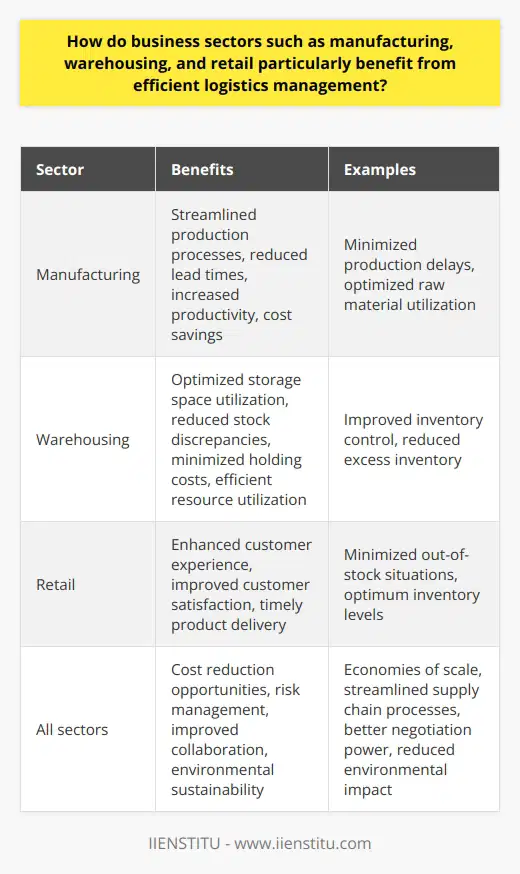
How do advancements in information and communication technology impact the coordination and synchronization of logistics processes?
Influence of Technological Progress on Logistics Coordination
Advancements in information and communication technologies (ICTs) significantly impact the coordination and synchronization of logistics processes. One major contribution of ICTs is the real-time exchange of data, which allows organizations to improve efficiency in their supply chain operations. As a result, all stakeholders can access accurate and timely information, which facilitates the optimization of resources.
Enhanced Collaboration
Another critical aspect of ICT involvement in logistics is the optimization of collaboration between different parties. The integration of supply chain management systems allows organizations to communicate seamlessly with partners, suppliers, and customers. Consequently, this improved connectivity fosters strategic relationships and encourages businesses to work together to achieve common objectives.
Automation and Prediction
ICT advancements also contribute to the automation of logistics processes, reducing human error and increasing overall efficiency. Furthermore, advanced analytics and machine learning techniques empower organizations to harness data effectively, enabling predictive actions based on historical patterns. For instance, companies can use data insights to forecast demands and streamline inventory management.
Acceleration of Decision-Making
The availability of real-time information significantly accelerates decision-making processes in logistics. Managers can monitor ongoing operations, instantly identify potential issues, and immediately make informed decisions to mitigate risks. Besides, these advanced technologies can support a proactive approach to address potential disruptions and provide essential contingency planning recommendations.
Cost Optimization and Resource Efficiency
Lastly, advancements in ICT facilitate cost optimization and resource efficiency within the logistics industry. It enables organizations to identify inefficiencies within their supply chain networks, then make strategic decisions concerning their transportation modes, warehousing systems, and labor allocation. With these accurate and data-driven decisions, companies can achieve long-term cost reduction while enhancing service quality.
In conclusion, the impact of ICT advancements on logistics coordination and synchronization is immense, as evidenced by improved information exchange, collaboration, automation, predictive capabilities, accelerated decision-making, cost optimization, and resource efficiency. By leveraging these innovations, logistics organizations can enhance their operational excellence, resulting in a more streamlined and synchronized supply-chain ecosystem.
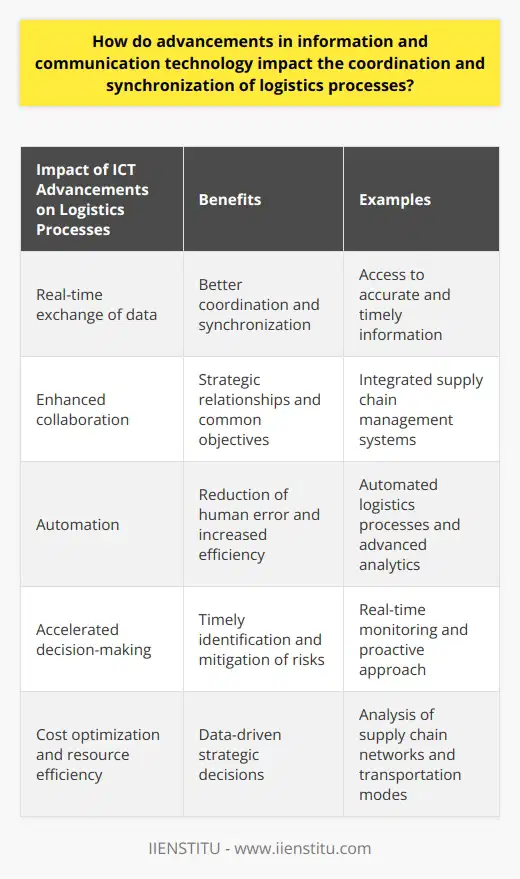
What are the critical factors to consider in the process of designing and implementing an effective logistics management system?
Critical Factors for Designing an Effective Logistics System
Understanding Stakeholder Requirements
An effective logistics management system can be achieved by considering the needs of all stakeholders involved, including customers, suppliers, and internal personnel. Identifying their priorities and expectations will help in the development of a system tailored to meet those requirements.
Supply Chain Visibility
A well-designed logistics system should offer real-time visibility into the supply chain. This includes tracking the movement of goods from suppliers to end-users. Visibility can be enhanced through the use of technology such as RFID tags, GPS tracking, and integrated software systems.
Optimizing Inventory Management
Inventory management plays a crucial role in ensuring the efficient movement of goods within the logistics process. It requires accurately forecasting demand, establishing appropriate stock levels, and implementing effective inventory control measures to prevent stockouts and minimize carrying costs.
Utilizing Advanced Technologies
The integration of advanced technologies, such as artificial intelligence, automation, and data analytics, can significantly enhance the effectiveness of a logistics management system. These technologies facilitate better decision-making, improve operational efficiency, and enable predictive and proactive planning.
Risk Management and Contingency Planning
A comprehensive approach to risk management is essential in the development of an effective logistics system. This involves identifying potential risks that may affect various aspects of the supply chain and developing contingency plans to mitigate those risks while maintaining operational efficiency.
Evaluating Performance Metrics
Regularly assessing the performance of a logistics management system is vital to ensure it remains effective. Key metrics may include on-time delivery performance, order accuracy, transportation costs, and inventory levels. Setting benchmarks and tracking progress against these indicators can help identify areas for improvement and guide ongoing system enhancements.
In summary, designing and implementing an effective logistics management system requires focusing on stakeholder requirements, increasing supply chain visibility, optimizing inventory management, leveraging advanced technologies, practicing effective risk management, and continually evaluating performance metrics. By addressing these critical factors, organizations can optimize the efficiency of their logistics operations and better navigate the complexities of today's global supply chains.
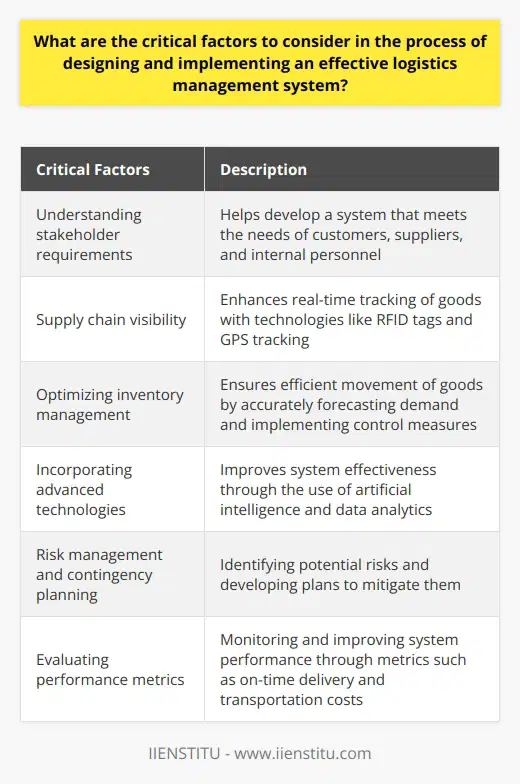
How does the integration of supply chain management and logistics management contribute to overall business performance and customer satisfaction?
Importance of Integrated Management
The integration of supply chain management and logistics management significantly contributes to overall business performance and customer satisfaction. By streamlining operations and reducing operational costs, companies can achieve efficiency and boost their competitiveness in the market. This alignment of strategies and processes helps businesses achieve a holistic approach, reducing complexities and redundancies in their systems.
Enhanced Collaboration and Communication
Effective communication between supply chain and logistics departments is crucial for ensuring a smooth flow of information. By adopting an integrated management approach, businesses can foster collaboration among stakeholders, sharing valuable data, and cross-functional insights in real-time. This facilitates better decision-making, process improvements, and anticipating potential risks, all of which contribute to improved customer satisfaction.
Optimized Inventory Management
Inventory management plays a critical role in meeting customer demands and maintaining optimal stock levels. Unified management of supply chain and logistics helps companies to monitor product flow, ensuring timely replenishment of high-demand items and reducing the risk of stockouts. This heightened visibility and control over inventory enable organizations to adopt lean and efficient operations, ultimately enhancing customer satisfaction.
Improved Lead Time and Order Fulfillment
Combining supply chain management and logistics management allows businesses to optimize their lead time, resulting in faster, more accurate order fulfillment. Timely execution of processes such as procurement, production, and transportation ensures that end consumers receive their products or services as quickly and efficiently as possible. This improved lead time promotes customer satisfaction, which can lead to increased brand loyalty and repeat business.
Risk Mitigation and Resilience
Incorporating a comprehensive approach to supply chain and logistics management provides businesses with the tools necessary to identify and mitigate potential risks. A seamless communication process and a clear understanding of dependencies within the supply chain enhance organizations' ability to react to disruptions quickly. As a result, businesses can implement risk mitigation strategies effectively, improving overall resilience and contributing to customer satisfaction.
In conclusion, integrating supply chain management and logistics management is crucial for businesses seeking to improve their overall performance and ensure customer satisfaction. By adopting a comprehensive approach, companies can effectively optimize inventory, minimize lead time, enhance collaboration, and mitigate risks involved in their operations. This holistic perspective yields countless advantages, from cost savings to customer loyalty, making it an essential consideration for businesses of all sizes.
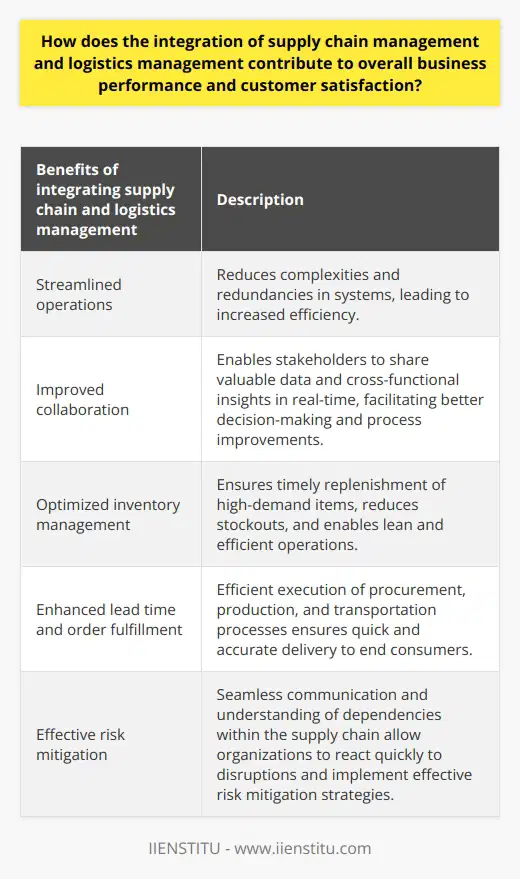
What role do key performance indicators (KPIs) play in measuring the success of logistics management strategies and initiatives?
Role of KPIs in Logistics Management
Importance of KPIs
Key performance indicators (KPIs) are crucial in evaluating the effectiveness of logistics management strategies and initiatives. They enable organizations to set goals and measure performance against predetermined targets. KPIs play a significant role in ensuring the success of logistics management by providing valuable insights into various aspects, such as efficiency, cost, customer service, and sustainability.
Facilitating Continuous Improvement
KPIs facilitate continuous improvement in logistics management by identifying areas requiring enhancements and enabling organizations to take informed decisions. Regularly monitoring KPIs allows organizations to detect weak points in their logistics management strategies and drive effective measures to improve overall performance. This can lead to increased operational efficiency, higher customer satisfaction, and reduced costs.
Enhancing Customer Satisfaction
Logistics management KPIs, such as on-time delivery, order accuracy, and transportation lead time, have a direct impact on customer satisfaction. By measuring indices related to customer service and satisfaction, organizations can identify opportunities for improvement and work to enhance their logistics service offerings. Improved customer service, in turn, leads to increased customer loyalty and long-term growth.
Optimizing Cost Management
Monitoring KPIs related to cost management, such as transportation cost per unit, warehousing cost, or staff productivity, enables organizations to optimize their logistics operations. Analyzing cost indicators helps organizations pinpoint inefficiencies, control expenses and streamline processes. Consequently, cost management KPIs support logistics providers in maximizing profitability while maintaining high-quality standards.
Driving Sustainability in Logistics
KPIs also play a vital role in promoting environmental sustainability in logistics management. By measuring indicators like greenhouse gas emissions, energy consumption, and waste reduction, organizations can evaluate the environmental impact of their logistics operations. This drives continuous efforts towards improved resource management, eco-friendly solutions, and innovative sustainable practices.
In conclusion, KPIs are integral to the success of logistics management strategies and initiatives. They provide insight into various aspects of logistics operations and facilitate informed decisions to drive continuous improvement, enhance customer satisfaction, optimize cost management, and promote sustainable practices.
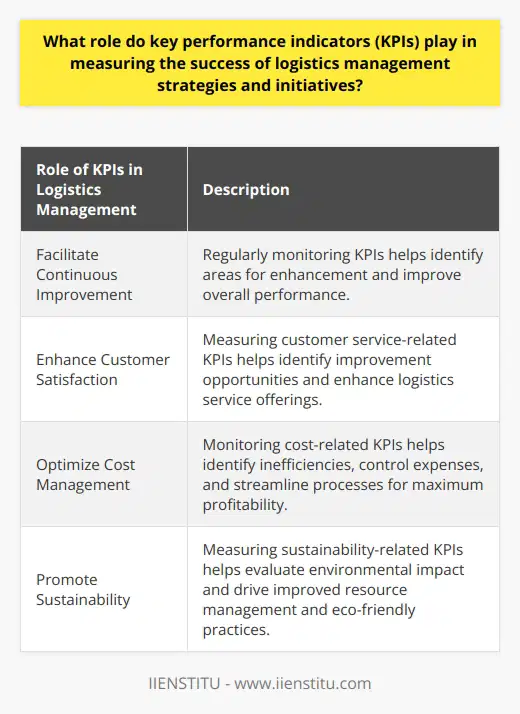
What is the difference between logistics and supply chain management, and how do these disciplines intersect?
Defining Logistics and Supply Chain Management
Logistics primarily focuses on the efficient transportation and storage of goods, ensuring that products are delivered on-time and undamaged from point A to point B. This involves the management of various transportation modes, warehousing, and inventory control. In contrast, supply chain management (SCM) encompasses a broader perspective, addressing how materials, information, and financial resources flow through the entire network of suppliers, manufacturers, distributors, and customers.
Examining the Ways They Intersect
The line between logistics and SCM can sometimes appear blurred due to their interconnected nature. In essence, logistics serves as a vital component within the larger SCM framework. As businesses strive to optimize their supply chain processes, efforts to streamline logistics activities – such as selecting appropriate transportation methods, maintaining accurate inventory count, and ensuring prompt delivery – become crucial to achieving operational efficiency.
Interdependence and Integration
SCM emphasizes the coordination and collaboration among all stakeholders within the supply chain. This includes incorporating logistics activities in a manner that facilitates the seamless flow of goods and information. The relationship between logistics and SCM is symbiotic, as logistics performance directly impacts the overall supply chain efficiency. For instance, proper inventory management can help prevent stock shortages or excess storage costs, thus fostering a competitive supply chain network.
Benefiting from Both Disciplines
Recognizing the distinction and integration between logistics and SCM is essential for businesses as it shapes their ability to respond to changing demands, mitigate risks, and improve customer satisfaction. Implementing robust logistics practices can lead to cost reductions, while effective SCM strategies build resiliency and adaptability within the supply chain. Ultimately, a harmonious integration between logistics and SCM can drive overall business performance and enhance stakeholder value.
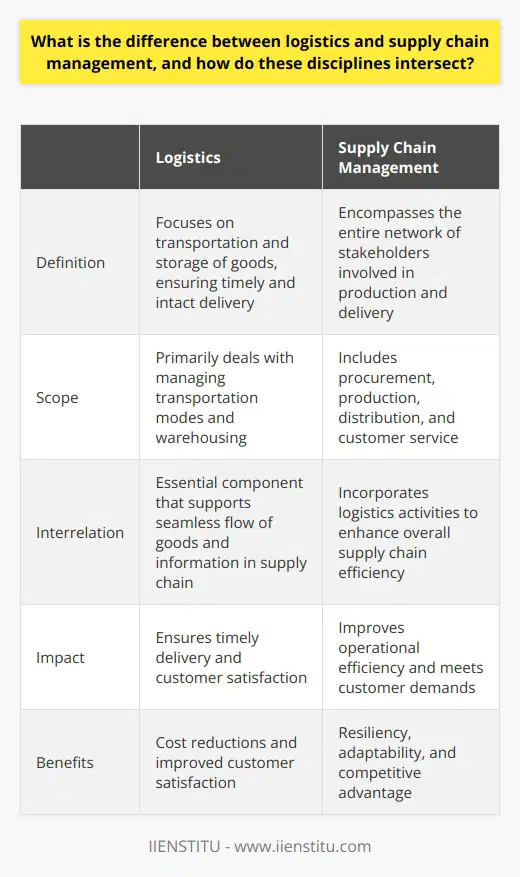
How do companies effectively manage reverse logistics and maintain sustainability in their operations?
Effective Reverse Logistics Management
To effectively manage reverse logistics and maintain sustainability in their operations, companies implement various strategies and practices. The first step is to conduct a comprehensive assessment of the returns process to identify areas of inefficiency and opportunities for improvement. By understanding the root causes of product returns, companies can take preventive measures to reduce the volume of returns and their associated costs.
Integration of Technology
Companies can leverage technology to support their reverse logistics operations. For instance, they use warehouse management systems (WMS) and inventory tracking software to optimize the handling and processing of returned products. These technologies enable companies to monitor their reverse logistics performance in real-time, allowing them to make data-driven decisions that contribute to increased efficiency and reduced environmental impact.
Collaboration with Stakeholders
Companies can enhance their reverse logistics management by fostering collaboration with various stakeholders, such as suppliers, manufacturers, and customers. This collaborative approach entails working closely with these stakeholders to develop sustainable product designs, responsible manufacturing processes, and effective return policies. Moreover, communication and coordination with stakeholders can help companies better anticipate potential reverse logistics challenges and devise appropriate solutions.
Reconditioning and Repurposing Products
One of the key aspects of sustainable reverse logistics management is the ability to recondition, refurbish, or remanufacture returned products. This practice extends the life cycle of returned goods and reduces the need for new production, which in turn minimizes resource consumption and waste generation. Companies can develop systems and processes that support the efficient reconditioning and repurposing of products to promote sustainability in their operations.
Engaging Third-Party Providers
Lastly, engaging third-party logistics (3PL) providers can help companies effectively manage their reverse logistics processes. By outsourcing reverse logistics management to expert 3PLs, companies can benefit from their specialized knowledge, skills, and resources in handling product returns. This partnership also affords companies the flexibility to scale their reverse logistics operations according to their needs, further contributing to their overall sustainability objectives.
In conclusion, effective reverse logistics management and sustainability maintenance can be achieved through various approaches, including process assessment, technological integration, stakeholder collaboration, product reconditioning, and engaging third-party providers. By adopting these strategies and practices, companies can make significant strides towards enhancing the efficiency and environmental impact of their reverse logistics operations.

What are the emerging trends in logistics management and how can organizations adapt to these changes for increased efficiency and competitiveness?
Emerging Trends in Logistics Management
One significant trend in logistics management is the utilization of advanced technology, such as artificial intelligence (AI), machine learning, and automation. These tools allow businesses to streamline operations, improve efficiency, and reduce costs, leading to increased competitiveness. Additionally, organizations must continue to adapt by investing in sustainable practices and the digitization of supply chains.
Leveraging AI and Machine Learning
The integration of AI and machine learning into logistics processes enables companies to analyze large amounts of data quickly and accurately, thus improving decision-making and reducing human error. For instance, machine learning algorithms can predict demand for specific products, allowing businesses to optimize inventory management and minimize stockouts or overstocks. Companies can adapt by investing in AI software and tools and training employees on their implementation to stay ahead of the competition.
Embracing Automation
Automation plays a crucial role in improving efficiency within logistics management. Companies are increasingly using robots, drones, and self-driving vehicles to perform repetitive tasks and transport goods. This shift not only saves time but also decreases labor costs and minimizes human intervention, reducing the likelihood of errors. Organizations can stay competitive by implementing automation technologies within their logistics operations.
Prioritizing Sustainability
With the increasing global focus on sustainability, many companies are scrutinizing their logistics operations to identify areas where they can reduce their environmental impact. For instance, businesses can adopt greener transportation modes such as electric vehicles, or optimize their transportation routes to reduce fuel consumption and emissions. By embracing sustainable logistics practices, organizations can maintain competitiveness and enhance brand reputation.
Digitizing Supply Chains
In today's increasingly digital era, there is a growing need for organizations to adopt sophisticated software solutions and digital communication channels to manage their supply chains more efficiently. Platforms that track product movement in real-time, enable better communication between suppliers, and provide analytics for informed decision-making are crucial for achieving a competitive edge. Companies can adapt to this trend by digitizing their supply chains and training staff to use the latest digital tools.
In conclusion, organizations looking to increase efficiency and competitiveness in logistics management must adapt to emerging trends, such as technological advancements, sustainability, and digitization. By doing so, they can streamline operations, optimize costs, and stay ahead in an ever-evolving industry.
